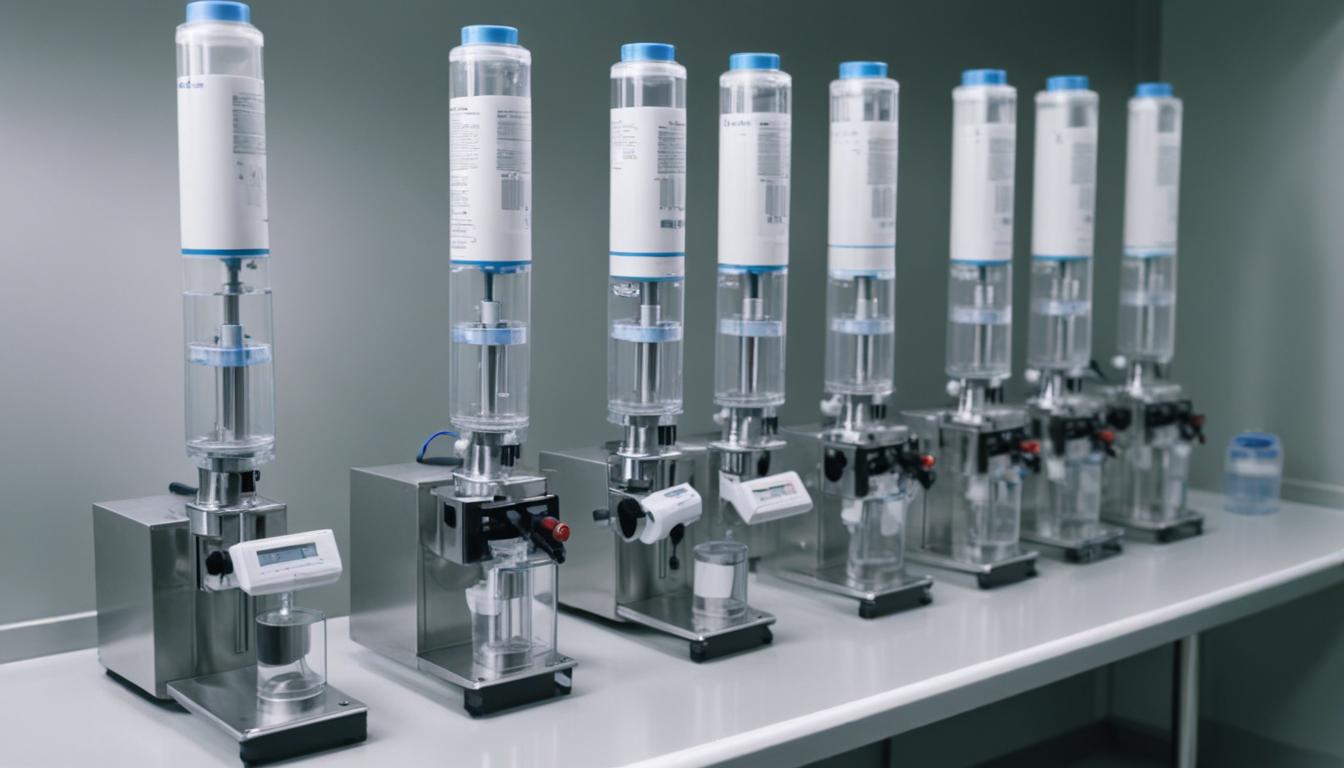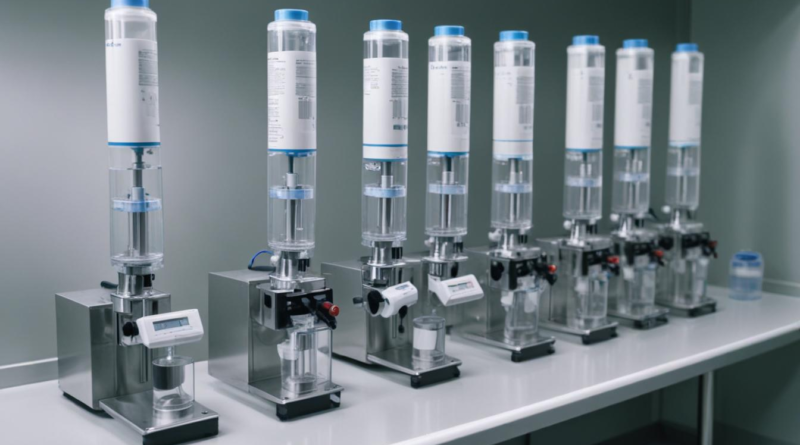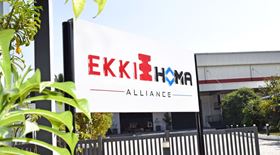pumps used in the pharmaceutical dispensing
Pharma dispensing pumps are essential for ensuring precision and reliability in the handling and administration of pharmaceutical liquids. Several types of pumps are utilized within this sector, each offering unique mechanisms and benefits tailored to specific dispensing needs.
- Syringe Pumps: These pumps provide highly accurate liquid delivery by moving a syringe plunger at a controlled rate. They are ideal for applications requiring precise dosing, such as in compounding pharmacies and research laboratories.
- Peristaltic Pumps: Utilizing a series of rollers that compress a flexible tube, peristaltic pumps offer gentle handling of sensitive fluids. They are particularly suitable for dispensing sterile or shear-sensitive pharmaceutical solutions.
- Gear Pumps: Known for their ability to handle viscous fluids, gear pumps use interlocking gears to move liquids. They are often employed in applications where consistent flow rates of thick medications are necessary.
- Diaphragm Pumps: These pumps operate by flexing a diaphragm to create suction and discharge. They are favored for their ability to handle a wide range of fluid viscosities and for their ease of maintenance.
- Piston Pumps: Offering high-pressure capabilities, piston pumps use reciprocating pistons to deliver precise volumes. They are commonly used in high-precision dosing and infusions in clinical settings.
| Pump Type | Key Characteristics | Typical Applications |
|---|---|---|
| Syringe Pumps | High accuracy, controllable flow rates | Research labs, compounding pharmacies |
| Peristaltic Pumps | Gentle on fluids, easy to sterilize | Sterile solutions, shear-sensitive medications |
| Gear Pumps | Handles viscous fluids, consistent flow | Thick medications, industrial pharmaceutical processes |
| Diaphragm Pumps | Versatile viscosity handling, low maintenance | Various liquid medications, flexible dosing applications |
| Piston Pumps | High precision, high pressure | Clinical infusions, precise dosing systems |
Each type of pump offers distinct advantages that cater to the diverse requirements of pharmaceutical dispensing. Selecting the appropriate pump type is crucial for optimizing the accuracy, efficiency, and safety of medication administration processes.
applications and uses
Pharma dispensing pumps play a pivotal role in various sectors of the pharmaceutical industry, ensuring that liquid medications are handled with the utmost precision and care. In compounding pharmacies, syringe and piston pumps are essential for the accurate preparation of personalized medications, allowing pharmacists to measure and dispense exact dosages tailored to individual patient needs. These pumps contribute to minimizing dosage errors and enhancing the overall safety of compounded treatments.
In research laboratories, diaphragm and peristaltic pumps are frequently utilized due to their ability to handle sensitive reagents and experimental compounds without introducing contaminants or causing degradation. Their gentle handling mechanisms are ideal for delicate procedures such as titrations, chemical syntheses, and automated assays, where maintaining the integrity of the substances is crucial for reliable results.
Sterile filling operations benefit significantly from the use of peristaltic and diaphragm pumps. These pumps ensure that injectable solutions are dispensed into vials and containers in a contamination-free environment. The non-contact nature of peristaltic pumps, combined with the precise control of diaphragm pumps, supports the maintenance of aseptic conditions required for high-quality pharmaceutical products.
In the realm of clinical infusions, piston and syringe pumps are indispensable for delivering intravenous medications at controlled rates. These pumps provide the necessary accuracy and reliability for patient treatments, ensuring that medications are administered safely and effectively over prescribed timeframes. The high-pressure capabilities of piston pumps, in particular, make them suitable for demanding infusion protocols in hospital settings.
High-throughput production environments leverage gear and diaphragm pumps to manage large volumes of viscous pharmaceutical formulations. Gear pumps, with their ability to handle thick liquids, are ideal for processes such as bulk medication preparation and industrial-scale manufacturing. Diaphragm pumps add versatility by accommodating a wide range of fluid viscosities, thus supporting diverse production requirements.
Automated packaging systems also depend on various types of pharma dispensing pumps to achieve seamless and efficient operations. Syringe pumps, with their high accuracy, are used for precise volume dispensing during the bottling and labeling stages, while peristaltic pumps ensure consistent flow rates across multiple channels, enhancing overall production efficiency.
Furthermore, biopharmaceutical applications often require the handling of biologically sensitive fluids, where the gentle action of peristaltic and diaphragm pumps helps preserve the activity and stability of biological products. These pumps are integral in processes such as cell culture media preparation, protein purification, and vaccine filling, where maintaining the integrity of the biological components is paramount.
Overall, the diverse applications of pharma dispensing pumps underscore their essential role in ensuring the accuracy, efficiency, and safety of pharmaceutical processes across various stages of drug development, production, and patient care.
key features and specifications
Pharma dispensing pumps are engineered with a variety of essential features and specifications that ensure their optimal performance in diverse pharmaceutical applications. Key aspects that define these pumps include flow rate accuracy, precision control, material compatibility, and user interface.
- Flow Rate Accuracy: High precision in flow rate control is critical for accurate dosing and consistent medication delivery. Pharma dispensing pumps typically offer flow rate accuracies within ±1%, ensuring reliable performance across different applications.
- Precision Control: Advanced control systems allow for programmable flow rates, enabling tailored dispensing protocols. Features such as automated ramp-up and ramp-down, as well as real-time flow monitoring, contribute to enhanced precision and adaptability.
- Material Compatibility: Pumps are constructed from materials that are compatible with a wide range of pharmaceutical fluids, including corrosive, viscous, and sterile solutions. Common materials include medical-grade stainless steel, silicone tubing, and specialized polymers that prevent chemical interactions and contamination.
- User Interface: Intuitive user interfaces with digital displays and touch-screen controls facilitate easy operation and configuration. User-friendly interfaces allow operators to set parameters, monitor pump performance, and receive alerts for maintenance or operational issues.
- Reliability and Durability: Designed for continuous operation, pharma dispensing pumps are built to withstand the rigors of high-throughput environments. Features such as redundant systems, robust construction, and quality components contribute to their long-term reliability and minimal downtime.
- Safety Features: Integrated safety mechanisms, including overpressure protection, leak detection, and automatic shut-off functions, ensure safe operation and prevent accidents or contamination during the dispensing process.
- Ease of Maintenance: Accessible designs and modular components facilitate routine maintenance and cleaning. Features like quick-change tubing systems and self-cleaning mechanisms reduce downtime and simplify upkeep procedures.
| Feature | Description | Importance |
|---|---|---|
| Flow Rate Range | 0.1 mL/hr to 10,000 mL/hr | Ensures suitability for various dispensing volumes, from small doses to bulk transfers. |
| Accuracy | ±0.5% to ±2% | Critical for precise dosing and maintaining medication integrity. |
| Control Interface | Digital touch-screen, programmable presets | Enhances user experience and operational flexibility. |
| Material Construction | Medical-grade stainless steel, silicone, specialized polymers | Prevents contamination and ensures compatibility with various pharmaceuticals. |
| Safety Mechanisms | Overpressure protection, leak detection, automatic shut-off | Ensures safe operation and minimizes risk of accidents. |
| Maintenance Features | Quick-change tubing, self-cleaning systems | Reduces downtime and simplifies routine maintenance tasks. |
Additionally, many pharma dispensing pumps incorporate connectivity options such as USB ports, Ethernet interfaces, and wireless capabilities, allowing for seamless integration with laboratory information management systems (LIMS) and other digital platforms. This connectivity facilitates data logging, remote monitoring, and automated reporting, which are essential for maintaining compliance with regulatory standards and enhancing operational efficiency.
The versatility in power options is another critical specification, with pumps available in both battery-operated and mains-powered configurations. Battery-operated models offer portability and are ideal for field applications, while mains-powered versions provide consistent power for stationary setups in production and laboratory environments.
Temperature control features are also significant in certain applications, where maintaining the stability of temperature-sensitive pharmaceuticals is paramount. Integrated heating and cooling elements allow for precise temperature regulation, ensuring that medications are dispensed under optimal conditions to preserve their efficacy and shelf life.
In summary, the key features and specifications of pharma dispensing pumps are meticulously designed to meet the stringent demands of the pharmaceutical industry. By combining high accuracy, robust control systems, material compatibility, and advanced safety and maintenance features, these pumps provide reliable and efficient solutions for precise medication dispensing.
advantages and limitations
 Pharma dispensing pumps offer numerous benefits that enhance the efficiency and accuracy of pharmaceutical dispensing processes. One of the primary advantages is their high precision in delivering exact volumes of medication, which is critical for patient safety and treatment efficacy. The ability to maintain consistent flow rates ensures that dosages are administered uniformly, reducing the risk of errors commonly associated with manual dispensing methods. This level of accuracy is particularly beneficial in compounding pharmacies and clinical settings where tailored dosages are essential.
Pharma dispensing pumps offer numerous benefits that enhance the efficiency and accuracy of pharmaceutical dispensing processes. One of the primary advantages is their high precision in delivering exact volumes of medication, which is critical for patient safety and treatment efficacy. The ability to maintain consistent flow rates ensures that dosages are administered uniformly, reducing the risk of errors commonly associated with manual dispensing methods. This level of accuracy is particularly beneficial in compounding pharmacies and clinical settings where tailored dosages are essential.
Another significant advantage is the automation capabilities of these pumps. Automated dispensing minimizes human intervention, thereby decreasing the likelihood of contamination and transcription errors. This not only streamlines operations but also enhances compliance with stringent regulatory standards, such as Good Manufacturing Practices (GMP) and Good Laboratory Practices (GLP). Additionally, the integration of digital interfaces and connectivity options allows for seamless data management, real-time monitoring, and remote control, further improving operational efficiency and traceability.
Versatility is another key benefit, as different types of pumps can handle a wide range of pharmaceutical formulations, including viscous liquids, sterile solutions, and sensitive biological products. This adaptability makes pharma dispensing pumps suitable for diverse applications, from high-throughput production lines to delicate laboratory experiments. Their ability to accommodate various fluid properties ensures that they can meet the specific needs of different medicinal products without compromising quality or performance.
The durability and reliability of these pumps are also noteworthy. Designed to operate continuously in demanding environments, pharma dispensing pumps are built with high-quality materials that resist wear and corrosion. This ensures long-term performance and reduces the frequency of maintenance, thereby lowering operational costs and minimizing downtime. Furthermore, many pumps come equipped with robust safety features, such as overpressure protection and leak detection, which safeguard both the equipment and the pharmaceutical products being handled.
Despite these advantages, there are several limitations associated with pharma dispensing pumps. One of the primary challenges is the initial investment cost, which can be substantial, especially for high-precision and specialized pump types. Smaller pharmacies or research laboratories with limited budgets may find it difficult to afford the latest dispensing technologies, potentially hindering their operational capabilities.
Another limitation is the complexity of maintenance and the need for specialized technical knowledge. Regular maintenance is essential to ensure optimal performance and prevent contamination, but this can require trained personnel and specific tools, adding to the overall operational costs. Additionally, frequent calibration may be necessary to maintain flow rate accuracy, which can interrupt workflow and delay dispensing processes.
Compatibility issues can also pose significant challenges. Not all pump types are suitable for every pharmaceutical formulation, and selecting the wrong pump can lead to inefficiencies or product degradation. For instance, peristaltic pumps, while gentle on fluids, may not be ideal for highly viscous medications, whereas gear pumps may cause shear stress on sensitive biological products. This necessitates a thorough understanding of both the pump mechanisms and the properties of the medications being dispensed.
Lastly, the space and integration requirements of advanced dispensing systems can be a limiting factor, particularly in facilities with limited infrastructure. Integrating pharma dispensing pumps with existing systems and workflows may require significant modifications, which can be both costly and time-consuming. Ensuring proper alignment and compatibility with other equipment is essential to achieve seamless operations, but this can be challenging in environments with diverse and evolving technological needs.
In summary, while pharma dispensing pumps provide substantial benefits in terms of precision, automation, versatility, and reliability, they also present challenges related to cost, maintenance, compatibility, and integration. Balancing these advantages and limitations is crucial for pharmaceutical facilities aiming to optimize their dispensing processes and maintain high standards of quality and safety.
| Advantages | Limitations |
|---|---|
|
|
future trends and developments
Advancements in technology are driving significant innovations in pharma dispensing pumps, shaping the future landscape of pharmaceutical dispensing. One major trend is the increasing integration of Internet of Things (IoT) and Artificial Intelligence (AI) technologies. By embedding smart sensors and connectivity features, pumps can communicate real-time data to centralized systems, enabling enhanced monitoring, remote control, and predictive maintenance. This connectivity not only improves operational efficiency but also ensures higher levels of precision and reliability in dispensing processes.
Another emerging trend is the advancement of automation and robotics in pharmaceutical dispensing. Automated systems are becoming more sophisticated, allowing for fully integrated dispensing lines that can handle complex workflows with minimal human intervention. This shift towards automation enhances consistency, reduces the potential for human error, and increases throughput, making it ideal for high-demand pharmaceutical manufacturing environments.
Miniaturization and portability of dispensing pumps are also gaining traction, particularly with the rise of decentralized and personalized medicine. Portable pumps are being developed to cater to point-of-care settings and home healthcare, providing patients with precise medication dosing in a compact and user-friendly form factor. This trend supports the growing demand for individualized treatment regimens and improves patient compliance and comfort.
Sustainability is another crucial focus area, with manufacturers developing eco-friendly pumps that prioritize energy efficiency and the use of recyclable or biodegradable materials. Innovations in pump design aim to reduce energy consumption and minimize environmental impact, aligning with the pharmaceutical industry’s broader commitment to sustainable practices.
Material science advancements are enhancing the compatibility and longevity of pharma dispensing pumps. The development of new polymers and coatings that resist chemical corrosion and biofouling extends the lifespan of pumps and ensures consistent performance when handling a wide variety of pharmaceutical formulations. These materials also contribute to maintaining the sterility and integrity of sensitive medications.
Regulatory compliance and safety enhancements continue to evolve, with future pumps incorporating more advanced safety features to meet stringent industry standards. Enhanced leak detection, automatic shut-off mechanisms, and real-time compliance monitoring are becoming standard, ensuring that dispensing processes adhere to regulatory requirements and maintain the highest levels of product safety.
The rise of personalized medicine is also influencing pump technology, driving the need for systems that can deliver highly customized dosing regimens. Future pumps are being designed with greater flexibility and precision to accommodate individualized treatment plans, supporting the shift towards more patient-centric healthcare solutions.
Predictive maintenance powered by AI and machine learning algorithms is another significant development. By analyzing operational data, these systems can predict potential failures before they occur, allowing for proactive maintenance scheduling. This reduces downtime, extends the lifespan of equipment, and ensures uninterrupted dispensing operations.
| Future Trend | Description | Impact on Pharmaceutical Dispensing |
|---|---|---|
| IoT and AI Integration | Embedding smart sensors and AI for real-time data communication and analysis. | Enhances monitoring, precision, and predictive maintenance capabilities. |
| Advanced Automation | Implementing more sophisticated automated and robotic dispensing systems. | Increases consistency, reduces human error, and boosts production throughput. |
| Miniaturization and Portability | Developing compact and portable dispensing pumps for decentralized use. | Supports personalized medicine and improves patient compliance. |
| Sustainability Initiatives | Creating energy-efficient and environmentally friendly pump designs. | Reduces environmental impact and aligns with sustainable industry practices. |
| Material Science Innovations | Using advanced materials to enhance pump durability and compatibility. | Extends pump lifespan and ensures consistent performance with various formulations. |
| Enhanced Safety Features | Integrating advanced safety mechanisms and compliance monitoring. | Ensures adherence to regulatory standards and maintains product safety. |
| Personalized Medicine Support | Designing pumps capable of highly customized dosing regimens. | Facilitates individualized treatment plans and improves patient outcomes. |
| Predictive Maintenance | Utilizing AI and machine learning for proactive maintenance scheduling. | Reduces downtime and extends equipment lifespan through early fault detection. |
Furthermore, the development of modular pump systems is anticipated to become more prominent. Modular designs allow for easy upgrades and customization, enabling pharmaceutical facilities to adapt their dispensing systems to evolving needs without significant overhauls. This flexibility ensures that pump systems remain relevant and efficient as new types of medications and dispensing requirements emerge.
Biocompatible and sterile pump technologies are also on the horizon, particularly for applications involving biologics and cell therapies. These pumps will incorporate materials and designs that prevent contamination and maintain the viability of sensitive biological products throughout the dispensing process. Ensuring biocompatibility is critical for the successful administration of advanced therapeutics and personalized medicine.
In addition, data analytics and machine learning are expected to play a pivotal role in optimizing pump performance and dispensing accuracy. By leveraging large datasets, pharmaceutical companies can gain insights into dispensing patterns, identify inefficiencies, and implement data-driven improvements. This analytical approach supports continuous quality enhancement and operational excellence in pharmaceutical dispensing practices.
Overall, the future of pharma dispensing pumps is characterized by increased intelligence, automation, sustainability, and adaptability. These developments will not only enhance the precision and efficiency of pharmaceutical dispensing but also support the industry’s move towards more personalized, sustainable, and technologically advanced healthcare solutions.




Pingback: The Key Benefits of Piston Pump Function in Advanced Healthcare Equipment - ANTITECK